Deck 7: Welfare and Efficiency
Question
Question
Question
Question
Question
Question
Question
Question
Question
Question
Question
Question
Question
Question
Question
Question
Question
Question
Question
Question
Question
Question
Question
Question
Question
Question
Question
Question
Question
Question
Question
Question
Question
Question
Question
Question
Question
Question
Question
Question
Question
Question
Question
Question
Question
Question
Question
Question
Question
Question
Question
Question
Question
Question
Question
Question
Question
Question
Question
Question
Question
Question
Question
Question
Question
Question
Question
Question
Question
Question
Question
Question
Question
Question
Question
Question
Question
Question
Question
Question

Unlock Deck
Sign up to unlock the cards in this deck!
Unlock Deck
Unlock Deck
1/208
Play
Full screen (f)
Deck 7: Welfare and Efficiency
1
Analysis based on value judgments is called _____ analysis.
A)subjectivity-based
B)valuative
C)positive
D)normative
A)subjectivity-based
B)valuative
C)positive
D)normative
D
2
Normative analysis is analysis that focuses on:
A)identifying cyclical patterns that are repetitive.
B)what has happened and how the past varies from the present.
C)actual relationships, predictions of what will happen, and what the situation is.
D)what should happen or what ought to be, and it involves value judgments.
A)identifying cyclical patterns that are repetitive.
B)what has happened and how the past varies from the present.
C)actual relationships, predictions of what will happen, and what the situation is.
D)what should happen or what ought to be, and it involves value judgments.
D
3
Normative analysis focuses on making decisions based on:
A)values.
B)facts.
C)relationships.
D)predictions.
A)values.
B)facts.
C)relationships.
D)predictions.
A
4
Statements about what option should be chosen are _____ statements.
A)positive
B)normative
C)valuation
D)assessment
A)positive
B)normative
C)valuation
D)assessment

Unlock Deck
Unlock for access to all 208 flashcards in this deck.
Unlock Deck
k this deck
5
Analysis that describes what would happen if various actions were taken is _____ analysis.
A)partitioning
B)valuation
C)positive
D)normative
A)partitioning
B)valuation
C)positive
D)normative

Unlock Deck
Unlock for access to all 208 flashcards in this deck.
Unlock Deck
k this deck
6
The type of analysis that describes what is happening and makes predictions based on identified relationships is called _____ analysis.
A)positive
B)normative
C)valuation
D)voluntary
A)positive
B)normative
C)valuation
D)voluntary

Unlock Deck
Unlock for access to all 208 flashcards in this deck.
Unlock Deck
k this deck
7
Positive analysis is based on identifying _____ and _____.
A)values; judgments
B)facts; relationships
C)beliefs; options
D)priorities; scruples
A)values; judgments
B)facts; relationships
C)beliefs; options
D)priorities; scruples

Unlock Deck
Unlock for access to all 208 flashcards in this deck.
Unlock Deck
k this deck
8
What is positive analysis?
A)It prescribes what should happen, which involves value judgments.
B)It puts the options that are available in order of the priorities held by the decision maker.
C)It is based on beliefs about what is most important.
D)It describes what is happening, explains why it is happening, or predicts what will happen.
A)It prescribes what should happen, which involves value judgments.
B)It puts the options that are available in order of the priorities held by the decision maker.
C)It is based on beliefs about what is most important.
D)It describes what is happening, explains why it is happening, or predicts what will happen.

Unlock Deck
Unlock for access to all 208 flashcards in this deck.
Unlock Deck
k this deck
9
Which of the following statements is based on normative analysis?
A)We should protect the environment.
B)The temperature in the office room is 22 degrees centigrade.
C)When the burner beneath a pot of water on the stove is turned on, the water will heat up.
D)Mario is 24 years old.
A)We should protect the environment.
B)The temperature in the office room is 22 degrees centigrade.
C)When the burner beneath a pot of water on the stove is turned on, the water will heat up.
D)Mario is 24 years old.

Unlock Deck
Unlock for access to all 208 flashcards in this deck.
Unlock Deck
k this deck
10
Which of the following is a positive economic statement?
A)The government ought to balance its budget and eliminate the deficit.
B)That company with a 50% profit rate made too much profit at the expense of consumers.
C)If the government raises taxes, people will have less income available for purchases and saving.
D)A 10% inflation rate is too high and should be reduced.
A)The government ought to balance its budget and eliminate the deficit.
B)That company with a 50% profit rate made too much profit at the expense of consumers.
C)If the government raises taxes, people will have less income available for purchases and saving.
D)A 10% inflation rate is too high and should be reduced.

Unlock Deck
Unlock for access to all 208 flashcards in this deck.
Unlock Deck
k this deck
11
Which of the following is a normative statement?
A)If John works five extra hours a week at his job, he will have less time to study.
B)Mary is 20 years old.
C)There is a negative or inverse relationship between price and quantity demanded.
D)Unequal incomes are unfair.
A)If John works five extra hours a week at his job, he will have less time to study.
B)Mary is 20 years old.
C)There is a negative or inverse relationship between price and quantity demanded.
D)Unequal incomes are unfair.

Unlock Deck
Unlock for access to all 208 flashcards in this deck.
Unlock Deck
k this deck
12
Which of the following statements is based on positive analysis?
A)If the price of cars rises, fewer cars will be sold.
B)Wages are too low and should be raised.
C)The quality of education ought to be improved.
D)The best option is to raise the productivity expectations.
A)If the price of cars rises, fewer cars will be sold.
B)Wages are too low and should be raised.
C)The quality of education ought to be improved.
D)The best option is to raise the productivity expectations.

Unlock Deck
Unlock for access to all 208 flashcards in this deck.
Unlock Deck
k this deck
13
A government leader determines that the 5% unemployment rate is too high. She asks her staff to research policy options to reduce the rate and a few weeks later is given four options. Each option would reduce the rate by a different amount and at a different cost. The leader studies the options and chooses the one she feels is best for the country. In order, what types of analysis were used in this three-stage chain of events?
A)positive; positive; normative
B)positive; normative; positive
C)normative; positive; normative
D)normative, positive; positive
A)positive; positive; normative
B)positive; normative; positive
C)normative; positive; normative
D)normative, positive; positive

Unlock Deck
Unlock for access to all 208 flashcards in this deck.
Unlock Deck
k this deck
14
Ian's research indicates that at a price of $12, his firm would sell 100,000 units of output. He determines that sales of 100,000 units is too low for his preferences. He then explores his options to increase sales. In order, what types of analysis are used in this three-stage chain of events?
A)positive; positive; normative
B)positive; normative; positive
C)normative; positive; normative
D)normative, positive; positive
A)positive; positive; normative
B)positive; normative; positive
C)normative; positive; normative
D)normative, positive; positive

Unlock Deck
Unlock for access to all 208 flashcards in this deck.
Unlock Deck
k this deck
15
Which of the following statements reflects positive analysis?
A)Looking at the options, Mario should reduce the number of employees.
B)Mario's staff identifies four options for reducing costs.
C)Mario determines that his costs are too high.
D)Mario believes that his employees are his most important asset.
A)Looking at the options, Mario should reduce the number of employees.
B)Mario's staff identifies four options for reducing costs.
C)Mario determines that his costs are too high.
D)Mario believes that his employees are his most important asset.

Unlock Deck
Unlock for access to all 208 flashcards in this deck.
Unlock Deck
k this deck
16
Which of the following claims involves positive analysis?
A)Those with high incomes do not pay a fair share of their income in taxes.
B)Firms should pay workers based on their productivity.
C)Higher prices will cause the purchasing power of income to fall.
D)Wages should be higher so that those who work have a living wage.
A)Those with high incomes do not pay a fair share of their income in taxes.
B)Firms should pay workers based on their productivity.
C)Higher prices will cause the purchasing power of income to fall.
D)Wages should be higher so that those who work have a living wage.

Unlock Deck
Unlock for access to all 208 flashcards in this deck.
Unlock Deck
k this deck
17
Which of the following claims reflects normative analysis?
A)The minimum wage should be higher so that workers earn a living wage.
B)Higher prices mean that the purchasing power of income falls.
C)If the minimum wage were higher, companies that employ minimum wage workers would have higher costs.
D)Fewer people will buy cars if their price rises.
A)The minimum wage should be higher so that workers earn a living wage.
B)Higher prices mean that the purchasing power of income falls.
C)If the minimum wage were higher, companies that employ minimum wage workers would have higher costs.
D)Fewer people will buy cars if their price rises.

Unlock Deck
Unlock for access to all 208 flashcards in this deck.
Unlock Deck
k this deck
18
Economic surplus measures the value of a decision's:
A)total costs minus its net benefits.
B)total benefits minus its total costs.
C)total costs minus its benefits minus gains from exploitation.
D)benefits minus its costs plus externalities.
A)total costs minus its net benefits.
B)total benefits minus its total costs.
C)total costs minus its benefits minus gains from exploitation.
D)benefits minus its costs plus externalities.

Unlock Deck
Unlock for access to all 208 flashcards in this deck.
Unlock Deck
k this deck
19
What standard is used to determine the most efficient economic outcome?
A)lowest cost
B)highest benefit
C)largest economic surplus
D)smallest inequality
A)lowest cost
B)highest benefit
C)largest economic surplus
D)smallest inequality

Unlock Deck
Unlock for access to all 208 flashcards in this deck.
Unlock Deck
k this deck
20
The most efficient outcome in a set of options is the one with the:
A)largest economic surplus.
B)lowest total costs.
C)lowest total benefit.
D)smallest positive difference between benefits minus total cost.
A)largest economic surplus.
B)lowest total costs.
C)lowest total benefit.
D)smallest positive difference between benefits minus total cost.

Unlock Deck
Unlock for access to all 208 flashcards in this deck.
Unlock Deck
k this deck
21
From an economic perspective, the outcome that yields the greatest economic surplus is the:
A)least cost outcome.
B)outcome with the highest benefit.
C)outcome of least benefit-cost gap.
D)most efficient outcome.
A)least cost outcome.
B)outcome with the highest benefit.
C)outcome of least benefit-cost gap.
D)most efficient outcome.

Unlock Deck
Unlock for access to all 208 flashcards in this deck.
Unlock Deck
k this deck
22
The criterion of economic efficiency is that the _____ economic surplus that is generated, the _____ the outcome.
A)wider; deeper
B)narrower; better
C)more; better
D)more; worse
A)wider; deeper
B)narrower; better
C)more; better
D)more; worse

Unlock Deck
Unlock for access to all 208 flashcards in this deck.
Unlock Deck
k this deck
23
If raising taxes through Policy A yields more economic surplus than raising taxes through Policy B, then:
A) Policy A is more efficient and equitable than Policy B.
B) Policy A is more efficient than Policy B but may not be more equitable than Policy B.
C) Policy A is more equitable than Policy B but may not be more efficient than Policy B.
D) Policy A is less efficient and equitable than Policy B.
A) Policy A is more efficient and equitable than Policy B.
B) Policy A is more efficient than Policy B but may not be more equitable than Policy B.
C) Policy A is more equitable than Policy B but may not be more efficient than Policy B.
D) Policy A is less efficient and equitable than Policy B.

Unlock Deck
Unlock for access to all 208 flashcards in this deck.
Unlock Deck
k this deck
24
Which of the following statements is TRUE regarding economic efficiency?
A)Efficient outcomes will make everyone better off.
B)Efficient outcomes are also equitable.
C)Efficient outcomes rarely make everyone happy.
D)Efficiency is associated with minimizing economic surplus.
A)Efficient outcomes will make everyone better off.
B)Efficient outcomes are also equitable.
C)Efficient outcomes rarely make everyone happy.
D)Efficiency is associated with minimizing economic surplus.

Unlock Deck
Unlock for access to all 208 flashcards in this deck.
Unlock Deck
k this deck
25
Which of the following statements is FALSE regarding economic efficiency?
A)Efficient outcomes will not make everyone happy.
B)If it is efficient, it is also equitable.
C)Efficient outcomes have the possibility of making everyone better off.
D)The most efficient outcome is the one with the greatest economic surplus.
A)Efficient outcomes will not make everyone happy.
B)If it is efficient, it is also equitable.
C)Efficient outcomes have the possibility of making everyone better off.
D)The most efficient outcome is the one with the greatest economic surplus.

Unlock Deck
Unlock for access to all 208 flashcards in this deck.
Unlock Deck
k this deck
26
How are people affected when economic efficiency increases?
A)Everyone will be better off and happier.
B)Overall gains exceed any change in costs, but some people may be worse off.
C)Dissatisfaction is a risk because the higher output will be spread across a larger number of people.
D)Efficiency squeezes people, so they end up worse off.
A)Everyone will be better off and happier.
B)Overall gains exceed any change in costs, but some people may be worse off.
C)Dissatisfaction is a risk because the higher output will be spread across a larger number of people.
D)Efficiency squeezes people, so they end up worse off.

Unlock Deck
Unlock for access to all 208 flashcards in this deck.
Unlock Deck
k this deck
27
When economic efficiency rises, the _____, and the benefits _____ be spread across all the people.
A)total gains may or may not exceed costs; will
B)total gains may or may not exceed costs; may or may not
C)total gains exceed the costs; will
D)total gains exceed the costs; may or may not
A)total gains may or may not exceed costs; will
B)total gains may or may not exceed costs; may or may not
C)total gains exceed the costs; will
D)total gains exceed the costs; may or may not

Unlock Deck
Unlock for access to all 208 flashcards in this deck.
Unlock Deck
k this deck
28
The concept of equity focuses on:
A)efficiency.
B)fairness.
C)the level of economic surplus.
D)profit.
A)efficiency.
B)fairness.
C)the level of economic surplus.
D)profit.

Unlock Deck
Unlock for access to all 208 flashcards in this deck.
Unlock Deck
k this deck
29
Which of the following statements is FALSE regarding economic efficiency?
A)Everyone may not gain from a more efficient outcome.
B)It is possible for everyone to gain from a more efficient outcome.
C)Equity is a separate issue from efficiency.
D)Efficiency means minimizing surplus.
A)Everyone may not gain from a more efficient outcome.
B)It is possible for everyone to gain from a more efficient outcome.
C)Equity is a separate issue from efficiency.
D)Efficiency means minimizing surplus.

Unlock Deck
Unlock for access to all 208 flashcards in this deck.
Unlock Deck
k this deck
30
A key difference between equity and efficiency is that equity deals with _____ and efficiency focuses on _____.
A)equality; minimizing costs
B)minimizing costs; equality
C)maximizing welfare; fairness
D)fairness; maximizing economic surplus
A)equality; minimizing costs
B)minimizing costs; equality
C)maximizing welfare; fairness
D)fairness; maximizing economic surplus

Unlock Deck
Unlock for access to all 208 flashcards in this deck.
Unlock Deck
k this deck
31
Efficient outcomes:
A)will make everyone better off.
B)are equitable outcomes.
C)may not make everyone happy.
D)minimize wasteful economic surplus.
A)will make everyone better off.
B)are equitable outcomes.
C)may not make everyone happy.
D)minimize wasteful economic surplus.

Unlock Deck
Unlock for access to all 208 flashcards in this deck.
Unlock Deck
k this deck
32
Which of the following alternatives would yield the greatest economic surplus?
A)the most wasteful option
B)the most economically equitable option
C)the one that will make everyone happy
D)the most economically efficient option
A)the most wasteful option
B)the most economically equitable option
C)the one that will make everyone happy
D)the most economically efficient option

Unlock Deck
Unlock for access to all 208 flashcards in this deck.
Unlock Deck
k this deck
33
Which of the following statements is TRUE?
A)Economically efficient outcomes hold the possibility of making everyone better off.
B)Economically efficient outcomes will make everyone better off.
C)Economically efficient outcomes will increase equity.
D)Economically efficient outcomes will always reduce equity.
A)Economically efficient outcomes hold the possibility of making everyone better off.
B)Economically efficient outcomes will make everyone better off.
C)Economically efficient outcomes will increase equity.
D)Economically efficient outcomes will always reduce equity.

Unlock Deck
Unlock for access to all 208 flashcards in this deck.
Unlock Deck
k this deck
34
Marginal benefit minus price equals:
A)economic efficiency.
B)economic equity.
C)consumer surplus.
D)producer surplus.
A)economic efficiency.
B)economic equity.
C)consumer surplus.
D)producer surplus.

Unlock Deck
Unlock for access to all 208 flashcards in this deck.
Unlock Deck
k this deck
35
Consumer surplus equals:
A)total benefit minus total expenditure.
B)marginal benefit minus price.
C)marginal revenue minus price.
D)total revenue minus consumer expenditure.
A)total benefit minus total expenditure.
B)marginal benefit minus price.
C)marginal revenue minus price.
D)total revenue minus consumer expenditure.

Unlock Deck
Unlock for access to all 208 flashcards in this deck.
Unlock Deck
k this deck
36
People gain consumer surplus when they purchase an item:
A)at a price below the value of the benefit they receive from the item.
B)at an equitable price.
C)at a price above marginal revenue but lower than the cost of production.
D)with a marginal benefit below the price of the item.
A)at a price below the value of the benefit they receive from the item.
B)at an equitable price.
C)at a price above marginal revenue but lower than the cost of production.
D)with a marginal benefit below the price of the item.

Unlock Deck
Unlock for access to all 208 flashcards in this deck.
Unlock Deck
k this deck
37
Pule purchases four bottles of bathroom cleaner for $3 each. The maximum prices she would have been willing to pay for each bottle are $6 for the first bottle, $5 for the second bottle, $4 for the third bottle, and $3 for the fourth bottle. The marginal cost of producing the bottles is $2.50. What is Pule's consumer surplus on the fourth bottle of bathroom cleaner?
A)$6
B)$1
C)$.50
D)$0
A)$6
B)$1
C)$.50
D)$0

Unlock Deck
Unlock for access to all 208 flashcards in this deck.
Unlock Deck
k this deck
38
Chin purchases five protein bars at a price of $3 each. The marginal benefit he receives from each bar is $5 for the first bar, $4.50 for the second bar, $4 for the third bar, $3.50 for the fourth bar, and $3 for the fifth bar. The marginal cost of producing the bars is $2 each. What is Chin's consumer surplus on the fifth bar?
A)$0
B)$.50
C)$1
D)$2
A)$0
B)$.50
C)$1
D)$2

Unlock Deck
Unlock for access to all 208 flashcards in this deck.
Unlock Deck
k this deck
39
Chin purchases five protein bars at a price of $3 each. The marginal benefit he receives from each bar is $5 for the first bar, $4.50 for the second bar, $4 for the third bar, $3.50 for the fourth bar, and $3 for the fifth bar. The marginal cost of producing the bars is $2.50 each. What is Chin's total consumer surplus from the five bars that he purchased?
A)$0
B)$.50
C)$2.50
D)$5
A)$0
B)$.50
C)$2.50
D)$5

Unlock Deck
Unlock for access to all 208 flashcards in this deck.
Unlock Deck
k this deck
40
The highest price that Dara would be willing to pay for a particular vase is:
A)her consumer surplus on the vase.
B)the marginal benefit she would receive from the vase.
C)the most economically efficient price for the vase.
D)the most equitable price for the vase.
A)her consumer surplus on the vase.
B)the marginal benefit she would receive from the vase.
C)the most economically efficient price for the vase.
D)the most equitable price for the vase.

Unlock Deck
Unlock for access to all 208 flashcards in this deck.
Unlock Deck
k this deck
41
The highest price that Duke would be willing to pay for a particular video game is:
A)the most equitable price for the game.
B)the most economically efficient price for the game.
C)the marginal benefit he would receive from the game.
D)his consumer surplus on the game.
A)the most equitable price for the game.
B)the most economically efficient price for the game.
C)the marginal benefit he would receive from the game.
D)his consumer surplus on the game.

Unlock Deck
Unlock for access to all 208 flashcards in this deck.
Unlock Deck
k this deck
42
In a market graph, consumer surplus is the area:
A)between the demand curve and the supply curve.
B)above the price.
C)below the demand curve.
D)above the price and below the demand curve.
A)between the demand curve and the supply curve.
B)above the price.
C)below the demand curve.
D)above the price and below the demand curve.

Unlock Deck
Unlock for access to all 208 flashcards in this deck.
Unlock Deck
k this deck
43
(Figure: Demand Curve) Use the graph of a demand curve for balsamic vinegar to answer the question.
What is the total consumer surplus when three bottles of vinegar are sold at a price of $3 each?
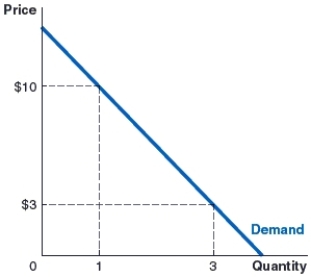
A)$21
B)$16.50
C)$10.50
D)$0
What is the total consumer surplus when three bottles of vinegar are sold at a price of $3 each?

A)$21
B)$16.50
C)$10.50
D)$0

Unlock Deck
Unlock for access to all 208 flashcards in this deck.
Unlock Deck
k this deck
44
(Figure: Demand Curve 2) Use the graph of a demand curve for monthly music streaming subscriptions to answer the following question. The vertical axis is the monthly price of a subscription and the horizontal axis is millions of monthly subscriptions for the market. What is the total consumer surplus if three million subscriptions are sold at a price of $4 each?

A)$8,000,000
B)$12,000,000
C)$15,000,000
D)$24,000,000

A)$8,000,000
B)$12,000,000
C)$15,000,000
D)$24,000,000

Unlock Deck
Unlock for access to all 208 flashcards in this deck.
Unlock Deck
k this deck
45
(Figure: Demand Curve 3) Use the graph of a demand curve for jars of laundry detergent to answer the question.
What is the total consumer surplus if 50 jars are sold at a price of $6?
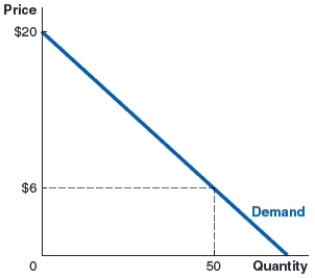
A)$14
B)$350
C)$700
D)$750
What is the total consumer surplus if 50 jars are sold at a price of $6?

A)$14
B)$350
C)$700
D)$750

Unlock Deck
Unlock for access to all 208 flashcards in this deck.
Unlock Deck
k this deck
46
Carlos buys six new plants for his garden. If he has purchased according to the rational rule, his consumer surplus on the sixth plant is equal to:
A)total benefit minus price.
B)price plus marginal benefit.
C)price minus marginal cost.
D)zero.
A)total benefit minus price.
B)price plus marginal benefit.
C)price minus marginal cost.
D)zero.

Unlock Deck
Unlock for access to all 208 flashcards in this deck.
Unlock Deck
k this deck
47
Pule is purchasing four bottles of bathroom cleaner for $3 each. The maximum prices she would have been willing to pay for each bottle are $6 for the first bottle, $5 for the second bottle, $4 for the third bottle, and $3 for the fourth bottle. The marginal revenue for each bottle is $2.50. What is Pule's total consumer surplus from purchasing the four bottles of bathroom cleaner?
A)$6
B)$2
C)$.50
D)$0
A)$6
B)$2
C)$.50
D)$0

Unlock Deck
Unlock for access to all 208 flashcards in this deck.
Unlock Deck
k this deck
48
When Chandra is hiking on a hot day without any water, she is willing to pay up to $6 for a bottle of water. When she does her grocery shopping, she is not willing to pay more than $3.60 for a case of 36 bottles of water. If Chandra buys a case of 36 bottles for $3.60, or $.10 per bottle, her consumer surplus is _____ on the first bottle and is _____ on the 36th bottle.
A)$106.20; $.10
B)$212.40; $106.20
C)$6; $.10
D)$5.90; $0
A)$106.20; $.10
B)$212.40; $106.20
C)$6; $.10
D)$5.90; $0

Unlock Deck
Unlock for access to all 208 flashcards in this deck.
Unlock Deck
k this deck
49
The producer surplus on a unit sold equals:
A)(price minus marginal cost) multiplied by (1/2 quantity sold).
B)price minus marginal cost.
C)marginal benefit minus price.
D)1/2 (price times quantity minus marginal cost).
A)(price minus marginal cost) multiplied by (1/2 quantity sold).
B)price minus marginal cost.
C)marginal benefit minus price.
D)1/2 (price times quantity minus marginal cost).

Unlock Deck
Unlock for access to all 208 flashcards in this deck.
Unlock Deck
k this deck
50
Price minus marginal cost equals the:
A)producer surplus of a unit sold.
B)consumer surplus of a unit purchased.
C)marginal benefit of a unit.
D)economic efficiency of total sales.
A)producer surplus of a unit sold.
B)consumer surplus of a unit purchased.
C)marginal benefit of a unit.
D)economic efficiency of total sales.

Unlock Deck
Unlock for access to all 208 flashcards in this deck.
Unlock Deck
k this deck
51
Portia produces and sells headbands. Her marginal cost for one headband is $6, and her average cost is $4. She gains producer surplus only when she sells headbands at a price above:
A)$4.
B)$6.
C)$5.
D)$10.
A)$4.
B)$6.
C)$5.
D)$10.

Unlock Deck
Unlock for access to all 208 flashcards in this deck.
Unlock Deck
k this deck
52
Joachim produces and sells baskets. His marginal cost for one basket is $10, and his average cost is $7. He gains producer surplus every time that he sells a basket at a price:
A)below $10.
B)below $7.
C)above $10.
D)above $7.
A)below $10.
B)below $7.
C)above $10.
D)above $7.

Unlock Deck
Unlock for access to all 208 flashcards in this deck.
Unlock Deck
k this deck
53
Jorge sells a hammock for $85. His marginal cost for one hammock is $40, and his average cost is $50. What is Jorge's producer surplus on the sale of one hammock?
A)-$5
B)$45
C)$35
D)$40
A)-$5
B)$45
C)$35
D)$40

Unlock Deck
Unlock for access to all 208 flashcards in this deck.
Unlock Deck
k this deck
54
The area on a market graph that lies below the price and above the supply curve is equal to:
A)producer surplus.
B)consumer surplus.
C)economic equity.
D)economic efficiency.
A)producer surplus.
B)consumer surplus.
C)economic equity.
D)economic efficiency.

Unlock Deck
Unlock for access to all 208 flashcards in this deck.
Unlock Deck
k this deck
55
If you are a seller making decisions according to the rational rule, you will:
A)earn some producer surplus on every unit sold.
B)earn producer surplus on all except the last unit sold.
C)ensure that all consumers earn consumer surplus.
D)ensure that consumers lose maximum surplus in order to lower producer surplus.
A)earn some producer surplus on every unit sold.
B)earn producer surplus on all except the last unit sold.
C)ensure that all consumers earn consumer surplus.
D)ensure that consumers lose maximum surplus in order to lower producer surplus.

Unlock Deck
Unlock for access to all 208 flashcards in this deck.
Unlock Deck
k this deck
56
When price equals marginal cost for the last unit sold, a seller will:
A)earn consumer surplus on every unit sold.
B)earn consumer surplus.
C)earn producer surplus on all except the last unit sold.
D)not earn any producer surplus overall.
A)earn consumer surplus on every unit sold.
B)earn consumer surplus.
C)earn producer surplus on all except the last unit sold.
D)not earn any producer surplus overall.

Unlock Deck
Unlock for access to all 208 flashcards in this deck.
Unlock Deck
k this deck
57
(Figure: Supply Curve) The graph shows the supply curve for jars of laundry detergent.
If 18 units are sold at a price of $20, what is the producer surplus on the last jar sold?
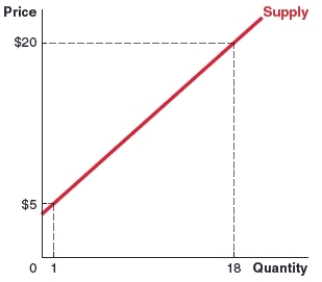
A)$0
B)$15
C)$135
D)$270
If 18 units are sold at a price of $20, what is the producer surplus on the last jar sold?

A)$0
B)$15
C)$135
D)$270

Unlock Deck
Unlock for access to all 208 flashcards in this deck.
Unlock Deck
k this deck
58
(Figure: Supply Curve) Use the graph of a supply curve for jugs of laundry detergent to answer the question.
If 18 jugs are sold at a price of $20, what is the total producer surplus?

A)$0
B)$15
C)$135
D)$270
If 18 jugs are sold at a price of $20, what is the total producer surplus?

A)$0
B)$15
C)$135
D)$270

Unlock Deck
Unlock for access to all 208 flashcards in this deck.
Unlock Deck
k this deck
59
(Figure: Supply Curve 2) Use the supply curve for bottles of dish soap in the graph to answer the question.
If 15 bottles are sold at a price of $8, what is the producer surplus on the last unit sold?
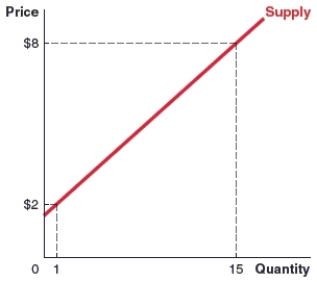
A)$0
B)$6
C)$45
D)$90
If 15 bottles are sold at a price of $8, what is the producer surplus on the last unit sold?

A)$0
B)$6
C)$45
D)$90

Unlock Deck
Unlock for access to all 208 flashcards in this deck.
Unlock Deck
k this deck
60
(Figure: Supply Curve 2) Use the supply curve for bottles of dish soap in the graph to answer the question.
If 15 bottles are sold at a price of $8, what is the total producer surplus?
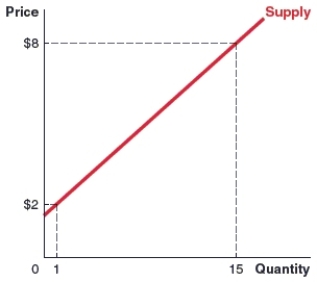
A)$0
B)$6
C)$45
D)$90
If 15 bottles are sold at a price of $8, what is the total producer surplus?

A)$0
B)$6
C)$45
D)$90

Unlock Deck
Unlock for access to all 208 flashcards in this deck.
Unlock Deck
k this deck
61
When trade is voluntary, who gains from it?
A)Either the seller or the buyer gains but not both.
B)Both the seller and the buyer gain, although not necessarily equally.
C)Both the seller and the buyer must gain equal amounts.
D)Neither the seller nor the buyer gains, but society in general gains.
A)Either the seller or the buyer gains but not both.
B)Both the seller and the buyer gain, although not necessarily equally.
C)Both the seller and the buyer must gain equal amounts.
D)Neither the seller nor the buyer gains, but society in general gains.

Unlock Deck
Unlock for access to all 208 flashcards in this deck.
Unlock Deck
k this deck
62
Voluntary exchange occurs when:
A)either the buyer or the seller will gain from the trade with no loss to the other.
B)either the buyer or the seller will gain from the trade at the expense of the other.
C)society in general rather than the participants will gain from the trade.
D)both the buyer and the seller will gain from the trade.
A)either the buyer or the seller will gain from the trade with no loss to the other.
B)either the buyer or the seller will gain from the trade at the expense of the other.
C)society in general rather than the participants will gain from the trade.
D)both the buyer and the seller will gain from the trade.

Unlock Deck
Unlock for access to all 208 flashcards in this deck.
Unlock Deck
k this deck
63
Which principle helps buyers and sellers make decisions about whether to trade?
A)the cost-benefit principle
B)the equity principle
C)the law of diminishing returns
D)the law of surplus
A)the cost-benefit principle
B)the equity principle
C)the law of diminishing returns
D)the law of surplus

Unlock Deck
Unlock for access to all 208 flashcards in this deck.
Unlock Deck
k this deck
64
When trade is voluntary, neither the buyer nor the seller will:
A)gain from the trade.
B)generate surplus.
C)be worse off after the trade.
D)need to make any payments.
A)gain from the trade.
B)generate surplus.
C)be worse off after the trade.
D)need to make any payments.

Unlock Deck
Unlock for access to all 208 flashcards in this deck.
Unlock Deck
k this deck
65
Which of the following statements about economic surplus is FALSE?
A)Economic surplus equals marginal benefit minus marginal cost.
B)Economic surplus is the area below the supply curve, above the demand curve, and to the right of quantity sold.
C)Economic surplus is the area between the supply curve and the demand curve to the left of quantity sold.
D)Economic surplus is consumer surplus plus producer surplus.
A)Economic surplus equals marginal benefit minus marginal cost.
B)Economic surplus is the area below the supply curve, above the demand curve, and to the right of quantity sold.
C)Economic surplus is the area between the supply curve and the demand curve to the left of quantity sold.
D)Economic surplus is consumer surplus plus producer surplus.

Unlock Deck
Unlock for access to all 208 flashcards in this deck.
Unlock Deck
k this deck
66
The marginal benefit minus the marginal cost equals:
A)the efficiency balance.
B)the consumer surplus minus the producer surplus.
C)the consumer surplus.
D)the economic surplus.
A)the efficiency balance.
B)the consumer surplus minus the producer surplus.
C)the consumer surplus.
D)the economic surplus.

Unlock Deck
Unlock for access to all 208 flashcards in this deck.
Unlock Deck
k this deck
67
Two ways to calculate economic surplus are _____ and _____.
A)consumer surplus minus producer surplus; marginal benefit plus marginal cost
B)marginal benefit minus marginal cost; consumer surplus plus producer surplus
C)marginal benefit minus price; marginal cost minus price
D)price minus marginal benefit; price minus marginal cost
A)consumer surplus minus producer surplus; marginal benefit plus marginal cost
B)marginal benefit minus marginal cost; consumer surplus plus producer surplus
C)marginal benefit minus price; marginal cost minus price
D)price minus marginal benefit; price minus marginal cost

Unlock Deck
Unlock for access to all 208 flashcards in this deck.
Unlock Deck
k this deck
68
Bae is willing to pay up to $160 for a particular pair of boots. She is able to buy the boots for $120. The marginal cost of producing the boots is $70. How large is the economic surplus associated with her purchase of the boots?
A)$40
B)$50
C)$90
D)$120
A)$40
B)$50
C)$90
D)$120

Unlock Deck
Unlock for access to all 208 flashcards in this deck.
Unlock Deck
k this deck
69
Bae is willing to pay up to $160 for a particular pair of boots. She is able to buy the boots for $120. The marginal cost of producing the boots is $70. Which of the following is TRUE regarding the economic surplus associated with her purchase of the boots?
A)Consumer surplus is $40, and producer surplus is $50.
B)Consumer surplus is $50, and producer surplus is $40.
C)Consumer surplus is $90, and producer surplus is $120.
D)Consumer surplus and producer surplus are the same.
A)Consumer surplus is $40, and producer surplus is $50.
B)Consumer surplus is $50, and producer surplus is $40.
C)Consumer surplus is $90, and producer surplus is $120.
D)Consumer surplus and producer surplus are the same.

Unlock Deck
Unlock for access to all 208 flashcards in this deck.
Unlock Deck
k this deck
70
(Figure: Market) Use the bath towel market graph to answer the question.
The bath towel market is at equilibrium. How large is the economic surplus?
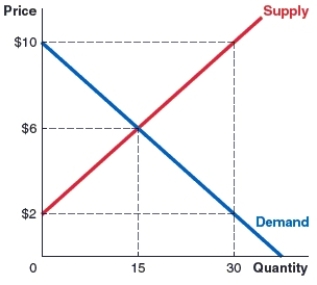
A)$60
B)$75
C)$120
D)$150
The bath towel market is at equilibrium. How large is the economic surplus?

A)$60
B)$75
C)$120
D)$150

Unlock Deck
Unlock for access to all 208 flashcards in this deck.
Unlock Deck
k this deck
71
(Figure: Market 2) Use the market graph for pairs of socks to answer the question.
The sock market is at equilibrium. How much economic surplus is being generated in the sock market?
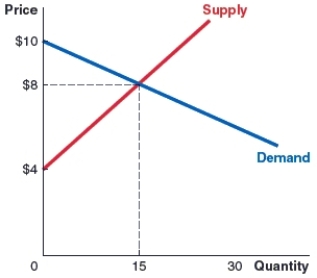
A)$45
B)$60
C)$90
D)$150
The sock market is at equilibrium. How much economic surplus is being generated in the sock market?

A)$45
B)$60
C)$90
D)$150

Unlock Deck
Unlock for access to all 208 flashcards in this deck.
Unlock Deck
k this deck
72
On a market graph, economic surplus can be identified as the area that is to the:
A)right of the quantity, above the demand curve, and below the supply curve.
B)left of the quantity, above the demand curve, and below the supply curve.
C)right of the quantity and between the demand and supply curves.
D)left of the quantity and between the demand and supply curves.
A)right of the quantity, above the demand curve, and below the supply curve.
B)left of the quantity, above the demand curve, and below the supply curve.
C)right of the quantity and between the demand and supply curves.
D)left of the quantity and between the demand and supply curves.

Unlock Deck
Unlock for access to all 208 flashcards in this deck.
Unlock Deck
k this deck
73
The price of a carton of eggs is $2, and 100 cartons are sold. The consumer surplus is $80, and total surplus equals $150. What is the producer surplus?
A)$200
B)$120
C)$70
D)$50
A)$200
B)$120
C)$70
D)$50

Unlock Deck
Unlock for access to all 208 flashcards in this deck.
Unlock Deck
k this deck
74
In modern society, most goods are allocated by:
A)governments.
B)banks.
C)ethnicities.
D)markets.
A)governments.
B)banks.
C)ethnicities.
D)markets.

Unlock Deck
Unlock for access to all 208 flashcards in this deck.
Unlock Deck
k this deck
75
Producing a given quantity of output at the lowest possible cost and lowest marginal cost is called:
A)minimizing production.
B)marginal minimization.
C)efficient production.
D)efficiency surplus.
A)minimizing production.
B)marginal minimization.
C)efficient production.
D)efficiency surplus.

Unlock Deck
Unlock for access to all 208 flashcards in this deck.
Unlock Deck
k this deck
76
Efficient production occurs when:
A)the marginal cost curve is downward sloping.
B)a given level of output is produced at the lowest possible cost.
C)output is minimized and cost is falling.
D)a given level of cost is able to produce a higher output level than before.
A)the marginal cost curve is downward sloping.
B)a given level of output is produced at the lowest possible cost.
C)output is minimized and cost is falling.
D)a given level of cost is able to produce a higher output level than before.

Unlock Deck
Unlock for access to all 208 flashcards in this deck.
Unlock Deck
k this deck
77
Efficient production decisions occur when _____ forces lead firms to produce the output level where ____.
A)market; average cost is at a minimum
B)market; price equals marginal cost
C)cost; average cost is at a minimum
D)cost; price equals marginal benefit
A)market; average cost is at a minimum
B)market; price equals marginal cost
C)cost; average cost is at a minimum
D)cost; price equals marginal benefit

Unlock Deck
Unlock for access to all 208 flashcards in this deck.
Unlock Deck
k this deck
78
When market forces lead to efficient production, each producer is _____, and the product is produced _____.
A)acting in self-interest; at the lowest possible marginal cost
B)coordinating with others; at a cost equal to price
C)alternating production; at minimum cost
D)maximizing production; at maximum marginal cost
A)acting in self-interest; at the lowest possible marginal cost
B)coordinating with others; at a cost equal to price
C)alternating production; at minimum cost
D)maximizing production; at maximum marginal cost

Unlock Deck
Unlock for access to all 208 flashcards in this deck.
Unlock Deck
k this deck
79
Markets distribute production across companies in a way that:
A)maximizes the number of firms.
B)minimizes production.
C)minimizes costs.
D)maximizes production.
A)maximizes the number of firms.
B)minimizes production.
C)minimizes costs.
D)maximizes production.

Unlock Deck
Unlock for access to all 208 flashcards in this deck.
Unlock Deck
k this deck
80
When goods are allocated in a way that creates the largest economic surplus:
A)output is evenly allocated across firms.
B)production is minimized.
C)efficient allocation has been achieved.
D)the marginal benefit of the last unit bought is the maximum marginal benefit.
A)output is evenly allocated across firms.
B)production is minimized.
C)efficient allocation has been achieved.
D)the marginal benefit of the last unit bought is the maximum marginal benefit.

Unlock Deck
Unlock for access to all 208 flashcards in this deck.
Unlock Deck
k this deck



